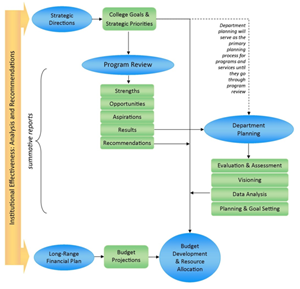Planning Framework
 As illustrated in the graphic at right, the centerpiece of the reimagined program/department planning process is Program Review, a self-study process that occurs on a five year cycle. Program review provides a structure for longer-term strategic planning and in-depth consideration of department-specific and cross-department issues and opportunities. Academic program reviews are led by program faculty and coordinated by the Academic Program Review Oversight Committee (APROC). Student Affairs and College Services program reviews are led by managers and classified staff.
As illustrated in the graphic at right, the centerpiece of the reimagined program/department planning process is Program Review, a self-study process that occurs on a five year cycle. Program review provides a structure for longer-term strategic planning and in-depth consideration of department-specific and cross-department issues and opportunities. Academic program reviews are led by program faculty and coordinated by the Academic Program Review Oversight Committee (APROC). Student Affairs and College Services program reviews are led by managers and classified staff.
Outcomes of program review include an in-depth assessment of program strengths, opportunities for improvement, aspirations, results (program-specific indicators), peer-review feedback, and specific recommendations for program improvement.
The overarching vision of Lane’s planning processes are to create organizational structures whereby strategic thinking, strategic and operational planning, and continuous assessment and improvement guide the work and decision making of the college.
Budget Development and Resource Allocation in the newly envisioned system will flow from program review and annual department plans, and will encompass all funding sources used in budget development to include existing budget, ICP, technology fee, Perkins and other grants, capital outlay, curriculum development, foundation, strategic investment/special projects, and staffing. After receiving feedback from Executive Deans and Vice Presidents, departments and project teams will submit specific budget proposals and recommendations for consideration and prioritization that are connected directly to their goals and project plans.
Overview of Program/Department Planning Processes
| Process | Cycle | Purpose | Responsible Party |
| Program Review | Year-long process occurring every five years | Self-study (faculty-led for academic programs) that provides a structure for in-depth assessment and long-term strategic planning - assessing quality, core learning outcomes, and student success - identifying and understanding program benchmarks and key performance indicators - evaluating and recognizing progress toward goals | Academic Program Review Oversight Committee (academic programs), Student Affairs and College Services Offices (services and support functions) Department manager, executive team and lead faculty/staff for implementation |
| Annual Department Plan | Annual process | A. Reflection of progress toward department and college-wide strategic goals and objectives, discussion of institutional priorities for the year ahead, visioning of department goals and area of focus for the coming year(s) (spring term) B. Compile and analyze year-end data elements and initial planning for year ahead (summer term staff work) C. Goal refinement, project planning and budget development (fall–winter term) D. Assessment and reflection (restart cycle) | Department manager with input from faculty staff and managers |
| Budget Development and Resource Allocation | Annual process (winter/spring) | Allocate resources from all available funding sources based upon department plans and prioritized needs | Department manager (submit budget plans and recommendations) Categorical funding committees, Budget & Finance Subcommittee, Executive Team, Board of Education (establish criteria and allocate resources) |
